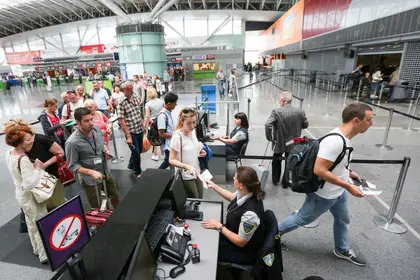Businesses in Ukraine are facing a major problem – human capital flight, or more plainly, a brain drain.
This was the key issue Ukraine’s European Business Association discussed during a round table at its office on Andriivskyi Uzviz on Feb. 28.
JOIN US ON TELEGRAM
Follow our coverage of the war on the @Kyivpost_official.
“What we see, is that people are not coming to work for us,” said Vitaliy Mykhaylov, the head of the EBA’s Human Resources Committee and general manager of World Staff, a recruiting company. “Most employers are planning to expand, and are creating jobs, but there’s no one to fill the spots.”
- Find the most up-to-date war in ukraine update in the Kyiv Post's daily news items for today.
- Find the latest Ukraine news published as of today.
For Mykhaylov’s company it has always been difficult to find people for top and middle management positions in Ukraine, but now it is hard to even find entry-level candidates, as many have left Ukraine in search of better job conditions.
Low pay
The top reason for that is Ukraine’s low salaries.
Ukraine’s official minimum wage is only Hr 3,720, or $139. This makes neighboring countries as Poland a more attractive option for employment for Ukrainians.
“A person living in Lviv pays 10 euros to go through the (Poland-Ukraine) border, and now they have access to 800-1,000 euros,” Mykhaylov said.
With Ukrainians gaining visa-free travel to most European Union in May 2017, it has become even easier for them to cross the border and find employment opportunities.
Although Ukrainians cannot officially work in the EU, they can find jobs in the shadow economy. A Ukrainian can work for up to three months in the EU and then “live off of this money in Ukraine,” said Tetyana Korol, director of the Financial-Economic Department of Ukraine’s Pension Fund.
The National Bank of Ukraine also recently expressed concern over Ukraine’s human capital flight.
The outflow of Ukraine’s human capital will remain high for the next 2-3 years, although it will even out in the long run, the NBU’s Serhiy Nikolaychuk told Polska Agencja Prasowa Biznes, a Polish news agency.
“Indeed, we see that the number of people ready to leave the country for jobs is increasing,” Nikolyachuk said. “Notice the significant difference in wages between Ukraine and Poland. The salary is about three times higher (in Poland), and it is impossible to quickly fix this.”

One measure that could be taken is to increase salaries, including the minimum salary, without increasing employment fees and taxes.
“Otherwise, every time we bring up the minimum salary, then all of the taxes officially go up as well,” said Anna Derevyanko, the EBA’s executive director.
Unpredictability
A second major issue is Ukraine’s unpredictable economic and political situation.
Valeriya Savchuk, a lawyer from Vasil Kisil and Partners, said that families would move outside of Ukraine if they have the opportunity to raise their children in better conditions.
“A lot of people are saying that they don’t know in which country their children will be living since they’re not confident that this country will be economically and politically successful. That’s why in order to take care of their children they go for better lives abroad.”
Creating better conditions for the worker is both the responsibility of the employer as well as the government. But apart from raising wages, improving conditions in the country is ultimately only something the government can do. For example, better infrastructure, education and pensions all are part of the equation.
As of January, Ukraine’s population was 42.3 million people according to the State Statistics Service. In 2017 alone, the country’s population decreased by 198,000.
But others say the population might be much lower than the official figures.
It’s difficult to establish Ukraine’s actual population, and it could vary anywhere between 35-45 million, Mikhaylov said. Of those, only up to 15 million people are paying taxes.
Ukraine’s IT professionals tend to be those who can more easily afford to emigrate from Ukraine. Ukraine’s DOU.ua, a popular online IT community, carried out a survey back in December 2017 among more than 8,000 Ukrainian IT professionals. Of those, 4 percent already emigrated, 9 percent are in the process of emigrating and 43 percent are considering a move.
Demographic gap
Ukraine is also experiencing a demographic gap, as there is a decreasing number of children born to enter the workforce in 15-20 years.
“In the 1990s there were 11 million children, and now there are 7 million,”Mikhaylov said.
Ella Libanova, an academic from the National Academy of Sciences of Ukraine who specializes in migration in Ukraine, says that the country will continue to lose its working force to other countries and that the age gap will continue to grow.
“The fact that the youth are leaving – this is very serious,” Libanova said. “The level of aging (of the population) in Ukraine is very high, and it will keep growing.”
One thing Ukraine can control is the quality of workers immigrating to Ukraine.
“All the time there are people coming from poorer countries to wealthier countries,” she said, adding that Ukraine should make sure that it is letting in those who will bring value to the country.
You can also highlight the text and press Ctrl + Enter




